Transformation Weight Control
transformationweightcontrol.com
A long blog but worth every word!
Defining Relapse – Two Approaches (From “Relapse Prevention” by Drs. Alan Marlatt and Judith Gordon. Now with Dennis Donovan in the second edition)
1. The pessimistic approach. Treatment failure, return to illness, falling back into addiction, failure and guilt, and breakdown. It’s an all-or-nothing definition, viewing relapse as the end of the road; a dead end. Dr. Marlatt would refer to this as the abstinence violation effect.
OR…
2. The optimistic approach. A single act of falling back, a single mistake, an error, a slip. The psychologist Albert Ellis said all humans are fallible, we’re all going to make mistakes. According to Dr. Marlatt, this single act could be called a “lapse”.
In Dr. Marlatt’s relapse prevention model, rather than the pessimistic approach, he views a lapse as “a fork in the road, with one path returning to the former problem (relapse or total collapse), and the other continuing in the direction of positive change.” I would suggest to you that even though the word “collapse” has more permanent associations, I believe it’s only permanent until it isn’t; that is, until you recover. Be sure to read my blog post, “The Secret to Losing Weight and Preventing Regain.” It’s all about resilience and recovery, which, although Dr. Marlatt doesn’t use the word “resilience”, he basically describes exactly that, and so it is an imperative in his RP model.
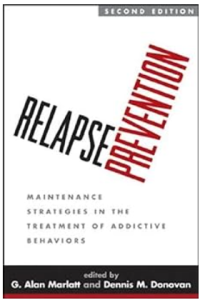
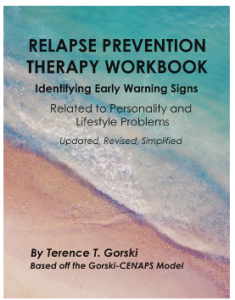
High-Risk Situations
No article about relapse prevention would be complete without discussing “high-risk situations.” In fact, it’s the hallmark feature of relapse prevention. Just like it sounds, a high-risk situation is where your adaptive, positive behaviors and sense of control (self-efficacy) are threatened.
A physical example of a high-risk situation is Thanksgiving dinner. You must contend with 1) the certainties of delicious smells and visions of the dinner table filled with food that is tempting beyond what you may be able to control, 2) the possibility of relatives you don’t care to spend time with, and 3) aunt Margie offering you cookies, telling you, “have just one more, I made them just for you.”
An emotional example of a high-risk situation is when you slip off your food plan, gain weight, and beat yourself up. That’s all-or-nothing, black and white, maladaptive perfectionistic thinking.
Curriculum and Strategies
I plan and write most of the behavior curriculum for our programs. In the beginning I thought that RP should be taught later in the program, but then I realized that all the skills involved in relapse prevention will help you right from the beginning of your weight control journey. After reading Dr. Marlatt’s book, and consistently observing
individuals struggling with the challenges of high-risk situations, I organized a relapse prevention curriculum into three parts:
1. Prevention of getting derailed by high-risk situations.
2. Managing the Moment when you’re stuck right in the middle of a high-risk crisis.
3. Recovering from the high-risk situation once it’s over.
PREVENTION STRATEGIES
1. Predict and Plan. The hallmark strategy of relapse prevention is to predict what will happen and plan for it. For instance, everyone knows what to expect at Thanksgiving. There shouldn’t any surprises. Since that’s the case, then predicting what will happen and planning ahead of time makes the most sense to avoid trouble. To Predict and Plan, write down what you expect to happen and create a plan for how you will cope, then rehearse by going over and over in your head your predictions and your plan until you’re confident you will handle it. Practice and review with a friend if necessary.
2. Problem solve. Do it with a trusted friend if necessary. Review all the possible solutions, no matter how silly they may seem, and, don’t judge them. Then pick the top few that you know will be most helpful.
3. Getting familiar with your internal triggers (anxiety, irritability, stress, anger, boredom, low self-esteem) and external triggers (people, places, or things that remind one of slips)
4. Avoid the four most common weight loss goal-setting mistakes:
1. Ease with which you’ll lose the weight.
2. Speed with which you’ll lose it.
3. Amount you’ll lose, and
4. How much life will change once you lose it.
5. Decrease sleep deprivation, alcohol consumption, and television watching
6. Self-care. Exercise, healthy nutrition, and taking your medications.
7. Covert antecedents. Decrease them. From Dr. Marlatt. What “hidden” or covert cause created a loss of control over the high-risk situation? Consider a strong food craving. You open the cabinet door in your kitchen and there is your favorite craving food. What’s it doing there? It was “covertly” hidden away, sometimes justified as, “well, if I have guests over, they might want some”, or “I have to feed them something”. That’s covert, the antecedents are the moments that preceded the craving heating up.
8. Increase social support and ability to ask for help, decrease social isolation, as well as practicing assertiveness and saying “no”.
9. Choice Points. (#9 in Prevention above) Review the decisions that lead to your slip. Review the arousal that caused the problems for you. Review the coping strategies in your toolbox that can help get you back on your feet. Review and sharpen your problem solving skills.
10. Improve resilience and self-compassion. Avoid maladaptive perfectionistic thinking.
11. Practice assertiveness and saying “No”.
12. Read “Food For Thought” by Hazelden. Read it every day. The pages are short (1-3 paragraphs per page). It’s daily readings for every day of the year for compulsive overeaters who seek to understand the role of food in their lives, supporting a life of physical, emotional, and spiritual balance. The book offers wise and comforting words for compulsive overeaters who seek to understand the role of food in their lives. Each day’s reading in this best-selling classic supports a life of physical, emotional, and spiritual balance.
13. Read “There’s a Hole In My Sidewalk” by Portia Nelson at the end of this blog.
MANAGING THE MOMENT STRATEGIES
- Breathe
- Breathe
- Breathe
- You get the idea
- Coping cards. The old-fashioned way so it imprints better in your brain, take index cards and with a pen or pencil write down every possible high-risk situation you may encounter and strategies you plan to use to deal with the situation. For instance, holiday parties, dinner with work colleagues, weddings, birthday parties, buffets, and so many more. There’s a woman in our program who has at last count 52 coping cards for 52 different possible high-risk scenarios. You could even think back to old high-risk situations that didn’t go so well and figure out and write down how you will handle it differently in the future. Then when high-risk situations are coming up, you have your index cards to rely on as your reminder and even a coach.
- Body scan, visual imagery, mindfulness meditation.
- Behavior chains. Do an “autopsy” of the day of your high-risk situation. Go over the day from moment to moment, hour to hour, until you identify what the beginning of the slip was, that is, what caused the moment when you started to slide or raised your arousal, or lowered your self-efficacy (the belief that “you can”)? Was it a fight with your boss or with a loved one? Internal stress related to low-self esteem or loss of confidence in your self-efficacy to deal with the high-risk situation; basically, look over all the possibilities. The understanding and insight of what lead you into trouble with the high-risk situation can help extricate you from it.
- Practice ABCs of Cognitive Behavior Therapy (CBT). A=Activating event, B=Belief (irrational), and C= emotional and behavioral consequence. Tune in to your thoughts at the moment of high-risk and challenge or dispute your irrational belief about the situation, and ask yourself these three questions: “is my thought true?” “Is my thought helping me?” “Is my thought kind or self-compassionate?” Most likely the answer is “no”, and instead of the negative emotional and behavior consequence, you are able to take a rational view of the situation and gain back control (it’s all about gaining back control).
- Talk to yourself, out loud if necessary. “Do I really want this second portion?” If you really do, then have some of it, otherwise, you can leave it. Taking control and responsibility for your behavior goes a long way toward controlling high-risk situations.
- Disassociate from yourself. Look at yourself as if you are in a movie and you are the director. Or speak to yourself in the third person, “Pete, do you really want that extra piece of pumpkin pie?” If you do, then have some, but before you do, remind yourself that it’s not the last piece of pumpkin pie on earth and you can always have more at alter time. And then if you still want it, deprivation will probably leave you feeling irritated and only obsess about the food. Over time, if you practice this technique, you’ll get better at it and gain more control.
- HALT Hungry, angry, lonely tired. A hallmark technique in addiction. Ask yourself if any of these things are going on for you in the high-risk moment.
- Excuse yourself. Go the bathroom, take a walk, get out of the situation even if just for a few moments to compose yourself. Escape is a very valid strategy, especially in addiction. It is NOT a cop out!
- Radical Acceptance. A page from Dialectical Behavior Therapy by psychologist Marsha Linehan. Acceptance the conditions as they are, and work with what you do have control over, and leave the parts you don’t. Nothing fits better than the serenity prayer here, even if you aren’t religious or have a belief in God. You can use any higher power, even yourself.
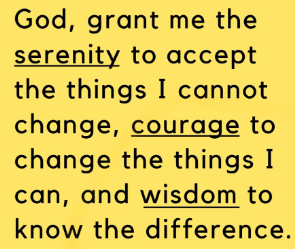
- Cognitive fusion and diffusion. Taking a page from Acceptance and Commitment therapy. You get fused to an idea that may not be helpful. Instead, diffusion is much more helpful. These cartoons illustrate the classic diffusion ACT “letting go of unhelpful thoughts or behaviors” instead of stubbornly fighting it.
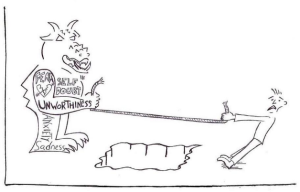
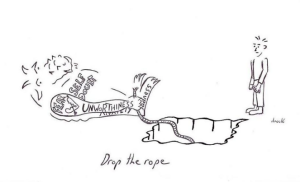
RECOVERY STRATEGIES
1. Resilience. Nothing is more important for managing body weight and preventing regain. It’s the ability to bounce back after adversity. How many times have you been “on plan” all week, only to weigh yourself at the end of the week and you gain? Do you let go of all your efforts, and let one day turn into a difficult week, month, months, or even years? Or you make a mistake, beat yourself up, and that turns into days, weeks, months, or even years of a lapse. Getting back on plan as soon as possible is at the heart of it. That’s resilience. 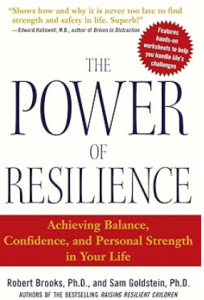
2. Practice USA. From psychologist Albert Ellis. Use unconditional-self acceptance as a reminder that all humans are fallible and you are allowed to make mistakes.
3. Common Humanity. You’re not alone! SEEK SUPPORT! Speak with people, ask for help. Avoiding isolation will reduce your shame about surrendering to the high-risk situation. Shame, isolation, and self-loathing are hallmarks of staying stuck and not recovering.
4. Renew Your Commitment. Use this opportunity as a time to recommit to what you want to accomplish.
5. Focus on Successes. Think about all of the changes that you have made and celebrate what you have accomplished. Use a gratitude journal if you are the type who keeps a diary, or give it a try even if you’ve never done it before.
6. Review your skills. Record keeping, exercise, stress management, HALT, problem solving, assertiveness.
7. Review the circumstances leading up to the mistake and the effect of the mistake on your self-efficacy.
8. Go for Your Goals. Take a look at your quarterly goals (especially a quarterly goal setting form if you have one) and review what you need to do to accomplish them.
9. Positive Affirmations. Affirmations are backed up by research. Keep calm, take a deep breath, relax your body, and remind yourself: I don’t do this anymore; One slip does not make a lapse; Mistakes are discreet, independent, and isolated events; This can stop here; It doesn’t have to happen next time; There is no failure, only feedback; I am a work in progress; Lapses are opportunities for new learning; A mistake is not a sign of total failure; It can be avoided in the future; Each attempt to change is a step forward, regardless of outcome; Mistakes are not a lack of willpower, character flaw, or lack of self-discipline.
There’s a Hole in My Sidewalk, by Portia Nelson
Chapter One
“I walk down the street.
There is a deep hole in the sidewalk.
I fall in.
I am lost… I am helpless.
It isn’t my fault.
It takes forever to find a way out.
Chapter Two
I walk down the same street.
There is a deep hole in the sidewalk.
I pretend I don’t see it.
I fall in again.
I can’t believe I am in the same place.
But, it isn’t my fault.
It still takes me a long time to get out.
Chapter Three
I walk down the same street.
There is a deep hole in the sidewalk.
I see it is there.
I still fall in. It’s a habit.
My eyes are open.
I know where I am.
It is my fault. I get out immediately.
Chapter Four
I walk down the same street.
There is a deep hole in the sidewalk.
I walk around it.
Chapter 5
I walk down another street.”
© 2024 Richard Weil All Rights Reserved
